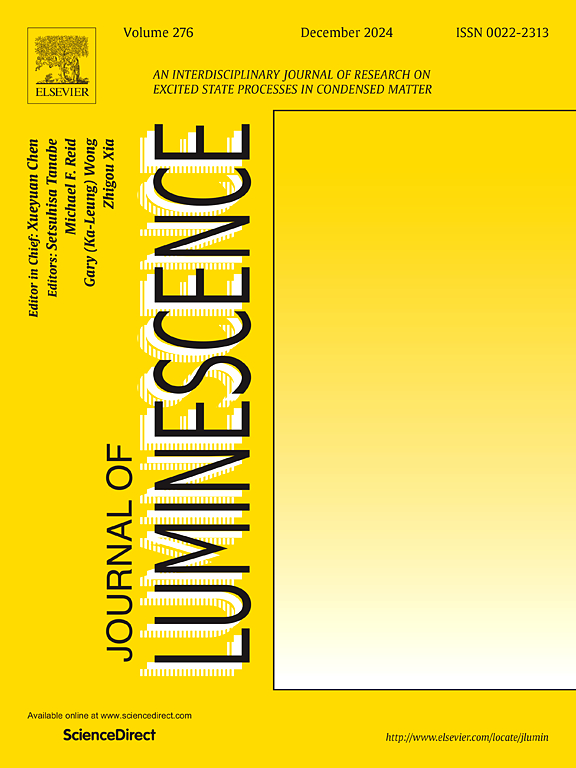Structural and luminescent properties of Eu3+ containing barium and zinc borate red phosphor glasses
IF 3.3
3区 物理与天体物理
Q2 OPTICS
引用次数: 0
Abstract
Eu3+ incorporated barium borate and zinc borate glasses of composition: (35−0.50x)BaO-(65−0.50x)B2O3-xEu2O3 and (50−0.50x)ZnO-(50−0.50x)B2O3-xEu2O3 (x = 0–5 mol%) were synthesized by the melt quenching in the temperature range: 1200–1400 °C. Structural, thermal and optical properties of glasses were studied by X-ray diffraction (XRD), Raman spectroscopy, Fourier Transform Infrared Spectroscopy (FTIR), Differential Scanning Colorimetry (DSC), 11B Magic Angle Spinning (MAS) Nuclear Magnetic Resonance (NMR), Vickers’ hardness tests, UV–visible and photoluminescence studies. The density of barium borate and zinc borate glass samples increase from 3.614 to 3.891(±0.005) g·cm−3 and from 3.393 to 3.804(±0.005) g·cm−3 respectively, upon increasing Eu2O3 concentration from 1 to 5 mol%. The glass transition temperature of both series increases with increasing Eu2O3 concentration. Raman and FTIR spectra show stretching and bending vibrations of B-O-B linkages in the BO4 and BO3 structural units. The hardness of barium borate and zinc borate glasses are 4.91(±0.21) and 4.63(±0.18) GPa respectively. The concentration of tetrahedral borons in barium borate and zinc borate glasses are 46(±1) % and 29(±1) % respectively. UV–visible spectra of glasses exhibit absorption bands due to transitions of Eu3+ from the 7F0,1 ground states to the excited states of Eu3+. The emission spectra of the samples containing Eu2O3 were measured at an excitation wavelength of 392 nm. Glasses emit intense red light and quenching of luminescence is observed at 3 and 4 mol% Eu2O3 concentration in barium borate and zinc borate glasses respectively. The emission intensity of barium borate glasses is found to be significantly higher than that of zinc borate glasses.
含Eu3+硼酸钡锌红色荧光粉玻璃的结构和发光性能
通过熔体淬火,在1200 ~ 1400℃的温度范围内合成了成分为(35 ~ 0.50倍)BaO-(65 ~ 0.50倍)B2O3-xEu2O3和(50 ~ 0.50倍)ZnO-(50 ~ 0.50倍)B2O3-xEu2O3 (x = 0 ~ 5 mol%)的Eu3+硼酸钡和硼酸锌玻璃。采用x射线衍射(XRD)、拉曼光谱(Raman spectroscopy)、傅里叶变换红外光谱(FTIR)、差示扫描比色法(DSC)、11B魔角旋转(MAS)核磁共振(NMR)、维氏硬度测试、紫外可见和光致发光研究了玻璃的结构、热、光学性能。当Eu2O3浓度从1 mol%增加到5 mol%时,硼酸钡和硼酸锌玻璃样品的密度分别从3.614增加到3.891(±0.005)g·cm−3和3.393增加到3.804(±0.005)g·cm−3。两系的玻璃化转变温度均随Eu2O3浓度的增加而升高。拉曼光谱和红外光谱显示了BO4和BO3结构单元中B-O-B键的拉伸和弯曲振动。硼酸钡玻璃和硼酸锌玻璃的硬度分别为4.91(±0.21)和4.63(±0.18)GPa。硼酸钡和硼酸锌玻璃中四面体硼的浓度分别为46(±1)%和29(±1)%。由于Eu3+从7F0,1基态跃迁到激发态,玻璃的紫外可见光谱呈现出吸收带。在392 nm激发波长处测量了含Eu2O3样品的发射光谱。在硼酸钡和硼酸锌玻璃中,Eu2O3浓度分别为3 mol%和4 mol%时,玻璃发出强烈的红光。硼酸钡玻璃的发射强度明显高于硼酸锌玻璃。
本文章由计算机程序翻译,如有差异,请以英文原文为准。
求助全文
约1分钟内获得全文
求助全文
来源期刊

Journal of Luminescence
物理-光学
CiteScore
6.70
自引率
13.90%
发文量
850
审稿时长
3.8 months
期刊介绍:
The purpose of the Journal of Luminescence is to provide a means of communication between scientists in different disciplines who share a common interest in the electronic excited states of molecular, ionic and covalent systems, whether crystalline, amorphous, or liquid.
We invite original papers and reviews on such subjects as: exciton and polariton dynamics, dynamics of localized excited states, energy and charge transport in ordered and disordered systems, radiative and non-radiative recombination, relaxation processes, vibronic interactions in electronic excited states, photochemistry in condensed systems, excited state resonance, double resonance, spin dynamics, selective excitation spectroscopy, hole burning, coherent processes in excited states, (e.g. coherent optical transients, photon echoes, transient gratings), multiphoton processes, optical bistability, photochromism, and new techniques for the study of excited states. This list is not intended to be exhaustive. Papers in the traditional areas of optical spectroscopy (absorption, MCD, luminescence, Raman scattering) are welcome. Papers on applications (phosphors, scintillators, electro- and cathodo-luminescence, radiography, bioimaging, solar energy, energy conversion, etc.) are also welcome if they present results of scientific, rather than only technological interest. However, papers containing purely theoretical results, not related to phenomena in the excited states, as well as papers using luminescence spectroscopy to perform routine analytical chemistry or biochemistry procedures, are outside the scope of the journal. Some exceptions will be possible at the discretion of the editors.
 求助内容:
求助内容: 应助结果提醒方式:
应助结果提醒方式:


